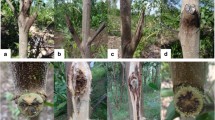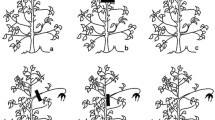Abstract
In New Zealand, the planting of cypresses is hindered by cypress canker disease caused by Seiridium cardinale (W.W. Wagener) B. Sutton & I.A.S. Gibson and S. cupressi (Guba) Boesew.). Pruning is widely practiced in established plantations to improve timber quality, although knowledge of its effect on disease incidence remains imperfect. Stubs of freshly cut branches on 275 trees of Cupressus macrocarpa Gordon & Leyland were inoculated with an isolate of either S. cardinale or S. cupressi to investigate the potential for pruning wounds to act as infection courts. In total, 75% of stubs inoculated at the edge, and 60% of those inoculated at the centre, became infected and produced stem cankers after 1 year, whereas cankers were formed on only 2% of non-inoculated control stubs. Incidence of cankers differed significantly between isolates. A second experiment was conducted at the same site 2 years later when stand infestation had increased, this time without inoculating but instead relying on ambient field inoculum. Stem cankers were produced on 11% of stubs on 162 trees, as a result of natural infection following pruning during periods of light rain in spring and summer. This investigation confirmed the ability of Seiridium species to invade through fresh pruning wounds on C. macrocarpa, and strengthens the recommendation to remove diseased plant material early, to maintain a low level of natural-spore inoculum within stands. It also indicates that pruning during wet weather should be avoided. Cleaning or disinfecting implements among trees may also be appropriate when conducting silvicultural operations in diseased plantations.
Similar content being viewed by others
References
Aimers-Halliday J, Dibley M, Faulds T, Low C (2002) Forest Research develops superior macrocarpa and lusitanica. New Zealand Tree Grower 23(2), 25–27.
Barnes I, Roux J, Wingfield MJ, Coetzee MPA, Wingfield BD (2001) Characterization of Seiridium spp. associated with cypress canker based on β-tubulin and histone sequences. Plant Disease 85, 317–321.
Beresford RM, Mulholland RI (1982) Susceptibility of farm shelter cypresses to three fungi associated with cypress canker disease. New Zealand Journal of Forestry Science 12, 7–13.
Birch TTC (1933) Gummosis diseases of Cupressus macrocarpa. New Zealand Journal of Forestry 3, 108–113.
Boesewinkel HJ (1983) New records of three fungi causing cypress canker in New Zealand, Seiridium cupressi (Guba) comb. nov. and S. cardinale on Cupressocyparis and S. unicorne on Cryptomeria and Cupressus. Transactions of the British Mycological Society 80, 544–547.
Chou CKS (1989) Morphological and cultural variation of Seiridium spp. from cankered Cupressaceae hosts in New Zealand. European Journal of Forest Pathology 19, 435–445. doi: 10.1111/j.1439-0329.1989.tb00281.x
Chou CKS (1990) Pathogenic variation of Seiridium spp. isolated from cankered Cupressaceae hosts in New Zealand. European Journal of Forest Pathology 20, 32–43. doi: 10.1111/j.1439-0329.1990.tb01271.x
Fuller CEK, Newhook FJ (1954) A report on cypress canker in New Zealand. New Zealand Journal of Agriculture 88, 211–220.
Gea LD, Low CB (1997) Genetic parameters for growth, form and canker resistance of Cupressus macrocarpa in New Zealand. New Zealand Journal of Forestry Science 27, 245–254.
Graniti A (1998) Cypress canker: a pandemic in progress. Annual Review of Phytopathology 36, 91–114. doi: 10.1146/annurev.phyto.36.1.91
Hood IA, Gardner JF, Kimberley MO, Gatenby SJ, Cox JC (2001) A survey of cypress canker disease. New Zealand Tree Grower 22(1), 38–41.
Krokene P, Barnes I, Wingfield BD, Wingfield MJ (2004) A PCR-RFLP based diagnostic technique to rapidly identify Seiridium species causing cypress canker. Mycologia 96, 1352–1354. doi: 10.2307/ 3762151
Madar Z, Solel Z, Sztejnberg A, Kimchi M (1991) Effect of pruning of trunk side-branches of cypress on infection by Seiridium cardinale and Diplodia pinea f. sp. cupressi. Forest Ecology and Management 44, 255–260. doi: 10.1016/0378-1127(91)90012-K
Miller JT, Knowles FB (1996) Introduced forest trees in New Zealand: recognition, role, and seed source. 9. The cypresses. Cupressus spp. Chamaecyparis spp. In ‘New Zealand FRI Bulletin No. 124’. 3rd edn. 33 pp. (Forest Research Institute: Rotorua, New Zealand)
Millner J, Murti Y (2006) Pruning of the cypress lusitanica. New Zealand Tree Grower 27(1), 34.
Moricca S, Børja I, Vendramin GG, Raddi P (2000) Differentiation of Seiridium species associated with virulent cankers on cypress in the Mediterranean region by PCR-SSCP. Plant Pathology 49, 774–781. doi: 10.1046/j.1365-3059.2000.00514.x
Rudd Jones D (1953) Studies of canker disease of cypresses in East Africa, caused by Monochaetia unicornis (Cooke & Ellis) Sacc. I. Observations on the pathology, spread and possible origins of the disease. Annals of Applied Biology 40, 323–343.
Self NM (2000) Cypress canker. New Zealand Tree Grower 21(2), 31–32.
Self NM, Chou CKS (1994) Pruning effect on incidence and severity of Seiridium cypress canker in a stand of Cupressus lusitanica. New Zealand Journal of Forestry Science 24, 75–77.
Sinclair WA, Lyon HH (2005) ‘Diseases of trees and shrubs.’ 2nd. edn. (Comstock Publishing Associates, Cornell University Press: Ithaca, NY, US)
Strouts RG (1973) Cankers of cypresses caused by Coryneum cardinale Wag. in Britain. European Journal of Forest Pathology 3, 13–24. doi: 10.1111/j.1439-0329.1973.tb00372.x
van der Werff HS (1988) Cypress canker in New Zealand plantations. New Zealand Journal of Forestry Science 18, 101–108.
Viljoen CD, Wingfield BD, Wingfield MJ (1993) Comparison of Seiridium isolates associated with cypress canker using sequence data. Experimental Mycology 17, 323–328. doi: 10.1006/emyc.1993.1030
Wagener WW (1939) The canker of Cupressus induced by Coryneum cardinale n. sp. Journal of Agricultural Research 58, 1–46.
Yamada T, Ito S (1995) Factors affecting the age-related resistance of hinoki stem to Seiridium unicorne infection. Journal of the Japanese Forestry Society 77, 66–71.
Author information
Authors and Affiliations
Corresponding author
Rights and permissions
About this article
Cite this article
Hood, I.A., Gardner, J.F., Hood, R.J. et al. Pruning and cypress canker in New Zealand. Australasian Plant Pathology 38, 472–477 (2009). https://doi.org/10.1071/AP09029
Received:
Accepted:
Issue Date:
DOI: https://doi.org/10.1071/AP09029




